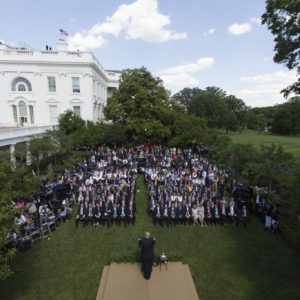President Trump has announced that he is withdrawing the United States from the Paris Climate Agreement. The oddest part of this decision is that remaining in this agreement wouldn’t have cost us all that much, and we’ll probably meet most of the targets anyways.
The same wasn’t true of the previous climate treaty, the Kyoto Protocol, which called for much deeper cuts at the time, and given the state of technology would have cost the United States a lot of money and jobs to comply.
The reality is that the United States has made and is making enormous strides toward reducing our carbon footprint. Whatever the president prefers, Americans have chosen higher gas mileage, fewer smokestacks and fewer carbon emissions. Our carbon emissions are already 11 percent below 2005 levels, or about 40 percent of the way toward the Paris Agreement.
Why have we done this? It is only part to do with government, the rest is due to innovation. In the last dozen years or so, innovation after innovation has occurred in the energy sector. Fracking has increased the supply of natural gas and lowered prices. As a result, natural gas has displaced coal as the preferred source of energy for new electricity production. Natural gas is half as carbon intensive as coal and it produces practically none of the other harmful emissions that cause respiratory ailments, so electricity companies have been shifting to natural gas quickly.
Renewables have also gotten a lot cheaper, so cheap in fact that they now account for 2 percent of our total energy consumption in the United States. Renewables are the fastest growing sector in the energy economy because they are getting cheap. The cost of solar power has fallen by 80 percent to 90 percent in the last decade due to innovation and economies of scale. Wind has been competitive with coal for years and continues be more widely adopted. Gasoline consumption in the United States has grown a bit recently due to lower gasoline prices, but has remained fairly stable because gas mileage has been increasing. In 1990 we produced 0.86 tons of carbon per $1,000 of income and today we produce only 0.30 tons.
Most of these gains have been driven by markets and states, not the federal government. Fracking was not a government mandate, yet it’s responsible for a large share of the reductions in carbon emissions in the United States.
State level policies have helped, especially clean-energy laws. But these have far-reaching benefits beyond the state boundaries. Californians have a strong preference for clean energy, so they mandate it. Their economy adapts, and the rest of us reap the rewards in terms of more efficient solar panels and wind power, and cheaper hybrid cars.
Lots of states now have laws that require some renewable energy production. What all these states have learned is that they can grow their economies while at the same time reducing their carbon intensity.
In addition to reducing emissions, we are also helping out by storing lots more carbon in trees, which are 50 percent carbon. Current estimates suggest that our forested landscape in the United States annually stores more than 900 million tons of carbon dioxide, offsetting 13 percent of our annual emissions. This is an amazing accomplishment, driven entirely by market forces that have freed land from agricultural production, reduced forest fires, and worked to increase the supply of timber for houses, furniture and paper.
Because of innovation and the cooperation of states with their leading industries, the United States has been reducing its carbon emissions. While the Paris Agreement encouraged us to continue these trends, the trend toward lower carbon emissions is gathering steam regardless.
This of course makes lots of people scratch their heads. We are using cleaner energy, lowering our carbon emissions and growing our economy. Why drop out of the Paris Agreement? Even a large number of companies in the United States have lobbied to stay in the agreement.
Whatever the logic, even without the federal government, carbon emissions are heading down, and this is good for the environment. Consumers and states have to hold their companies to their sustainability goals, and fortunately, given technological trends, this should not be too hard.

